Jupiter has a moderately standard orbit which deviates from 0.05 from circular orbit. It’s extreme and closest positions of the sun are roughly 47224327.985 miles apart; its aphelion is 8.1662*108 km from the sun while its perihelion is 7.4052*108 km from the sun. Jupiter has a rotational time of 0.414 days with a revolution period of approximately 11.86 earth years. Its orbit is inclined at 1.30530o and with an eccentricity of 0.048393.
- Jupiter orbits around the sun and takes 11.86 years to complete one orbit
- The distance of Jupiter from the earth taken on 4th June 2013 at 0655 hours GMT is 4.6 AU.
- The distance of Jupiter from the sun as of now is 5.12 AU. Measured on 4th June 2013 0640 hours GMT.
- Jupiter receives 0.03815 less sunlight than the earth due to its distance from the sun being greater than the earth’s distance from the sun.
- The exact discovery date of Jupiter is not precisely known. NASA foretells that it was discovered by the Ancients since it is mentioned in ancient texts (Nine Planets Organization, par 1). It is referred to as Marduk in prehistoric Babylonian manuscripts, Zeus in Greeks mythology and Jupiter in traditional Roman art (Nine Planets Organization, par 1). However the first exploration of Jupiter was done in 1610 by Galileo Galilei; through his rudimentary telescope he discovered that Jupiter had four large moons orbiting round it, i.e. Io, Europa, Ganymede and Callisto (Nine Planets Organization, par 3).
- The earliest spacecraft to travel to the planet was pioneer 10 in the year 1973. The pioneer 10 was intended to assess the potential of spacecrafts to endure motion in the asteroid belt and Jupiter’s magnetosphere (Nine Planets Organization, par 4).
- Numerous spaceship missions have been sent to Jupiter, the latest spacecraft to visit Jupiter being the New Horizons 2007. The spaceship was launched in January 2006 and flew by Jupiter on 28th February 2007 and is expected to reach Pluto in July 2016. New Horizons used Jupiter for a gravity aid in speeding up its expedition to Pluto. The spacecraft recorded lightning around the gas giant’s poles, formation of new ammonia haze, and boulder-size clumps (Harvey and Burdick, par 3). New Horizons gathered information on volcanic eruptions on Io (one of the four moons of Jupiter discovered by Galileo); it also took studies of Himalia and Elara, studied Jupiter’s Red Spot and the course of the ions and cations circumnavigating the magnetic tail of the planet. It also recorded data that supports the theory suggesting that Europa has an infinite quantity of liquid water underneath its icy outer layer.
- The New Horizons spaceship was a flyby mission. It is en route to Pluto and is projected to reach its destination by July 2016.
- The New Horizons spaceship has not yet visited another planet apart from Jupiter; it is however expected to get to Pluto in 2016.
- New Horizon is fixed with LORRI (a charge-coupled device (CCD) astronomic camera) designed for taking pictures. It also has various spectrometer devices for measuring spectra, namely: Alice; measures Ultraviolet Spectra, Ralph; measures infrared spectra and REX; uses radio waves (Beisse, par 1-5).
- The most fascinating discovery of this spaceship was the presence and development of ammonia clouds in Jupiter’s environment. This discovery may suggest that the planet receives acidic rain and that it is impossible for any life form to exist on the planet. Furthermore, plants would have abnormal growth due to excess ammonia nutrients.
- There is an additional spaceship that is projected to visit Jupiter in the near future, this is Juno; a NASA project to study Jupiter. It was launched on 5th August 2011 and is expected to arrive on July 2016. It is expected to study the formation of Jupiter; it will also map Jupiter’s gravity and magnetic fields plus the atmospheric composition.
- The atmosphere of Jupiter is mainly made up of hydrogen and helium gases. Hydrogen gas accounts for an estimated 84% of the total atmospheric gases while helium comprises of approximately 15%. There are also traces of water vapor, acetylene, ammonia, ethane, phosphine and other simple molecules in minute ratios (Thinkquest Education Foundation, par 5). Pressure and heat accumulates as one moves into the lower atmospheric zones where hydrogen is condensed to aqueous metallic hydrogen. The liquid metallic hydrogen has electrical conducting properties that generate a strong magnetic field due to Jupiter’s high-speed rotation.
- Jupiter has three separate layers of clouds that could be observed. These cloud layers consist of ammonia ice, ammonium hydrosulfide and a mixture of ice and water (Nine Planets Organization, par 12). The clouds on Jupiter alternate in layers and cover the entire planet. Below are photographs of Jupiter clouds.
Image of clouds as seen from New Horizons
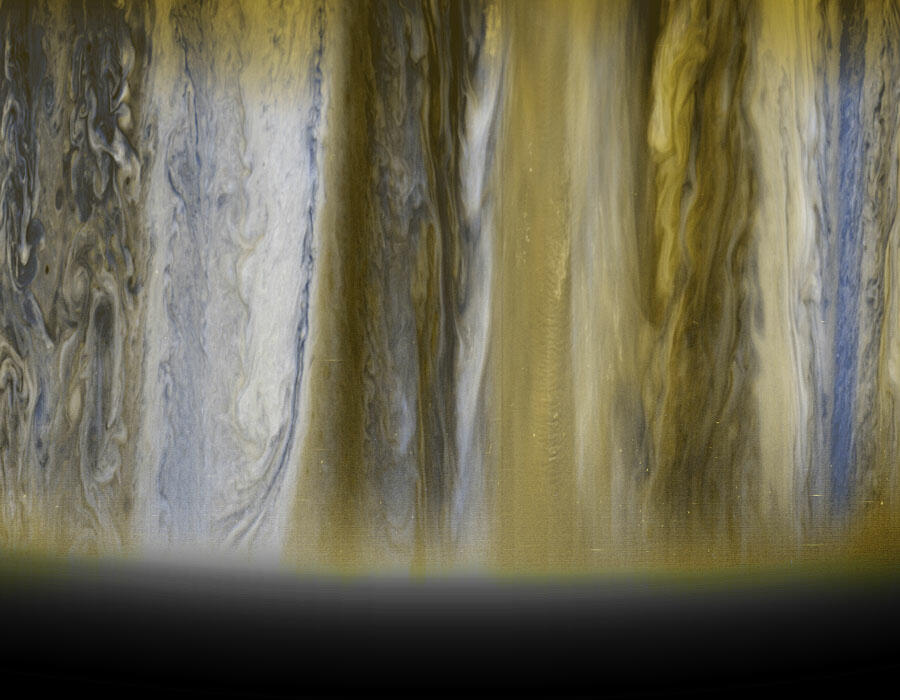
3D View of Jupiter Cloud
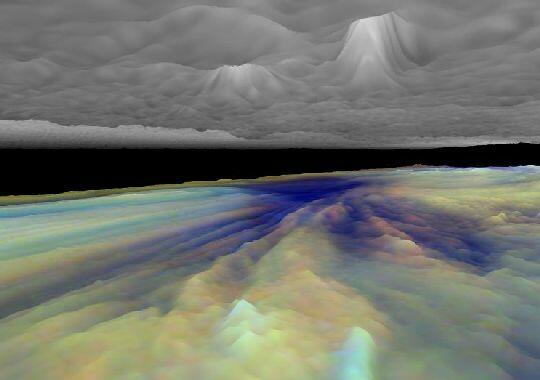
Note: the distance of separation and height variations are exaggerated on this photograph. The higher cloud consists of vapor whose thickness extends several miles. In the lower layers, the light blue areas represent thin clouds; the red fractions are low while the white ones are elevated and thick.
- The temperature of Jupiter’s atmosphere at 1 bar is estimated at 165 K.
- Jupiter has high pace winds that are restricted in wide groups of latitude (Nine Planets Organization, par 14). A fierce storm moving across the cloud tops can be observed on Jupiter. The strongest winds are experienced on the planet’s northern latitudes where the winds move at approximately 370 miles per hour Jupiter’s atmosphere is unstable and data hints that these winds are produced from its inner heat. The Great Red Sport is as a result of an atmospheric disturbance resembling a hurricane and is an evidence for existence of storms on Jupiter.
A photographic image of the Great Red Spot of Jupiter
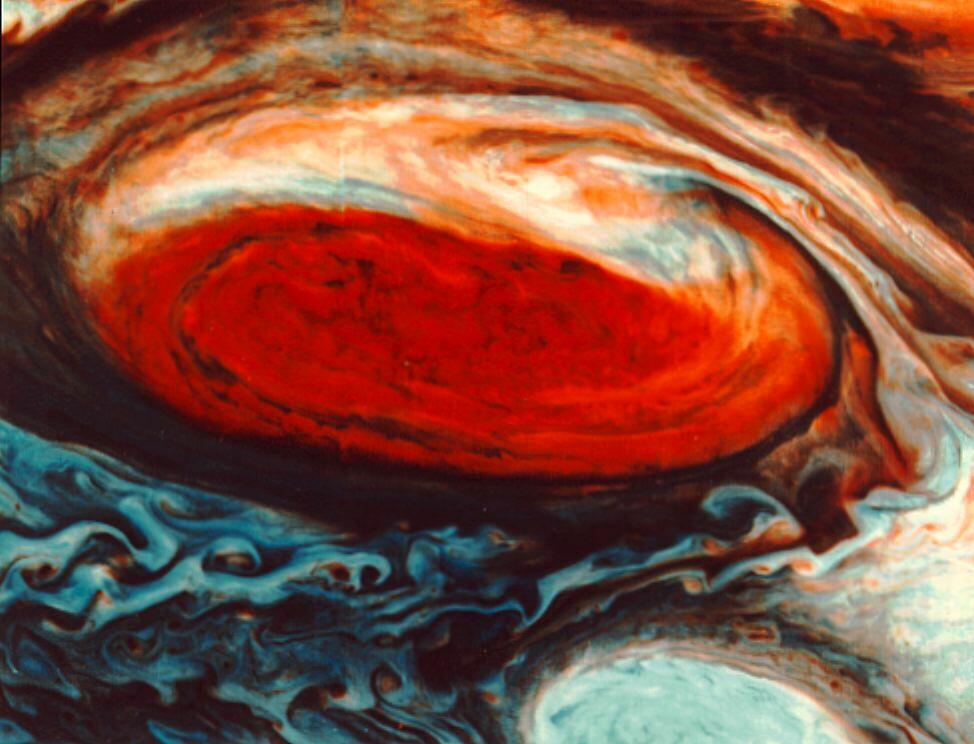
The Great Red Spot and stormy clouds on Jupiter
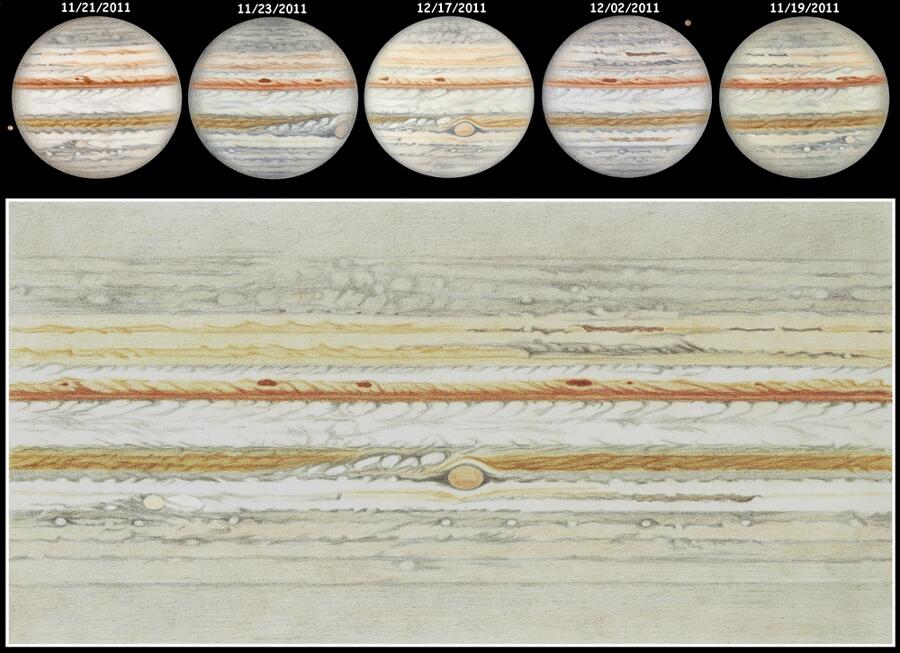
Jupiter’s winds are mostly caused by its internal heat and not by heat from the sun as is common with winds on Earth.
There is no specific theory put forward to explain the origin of Jupiter’s atmosphere, however, recent forms propose that initially a solid mass of approximately 10 times larger than the earth’s mass was formed due to the accumulation of frozen celestial bodies. The core developed an atmosphere due to release of gases during accumulation and as its mass increased, it attracted gases from the surrounding solar nebula and accumulated hydrogen and helium gases which presently constitute Jupiter’s atmosphere (Owen, par 2).
Spectrometer of Jupiter’s atmosphere
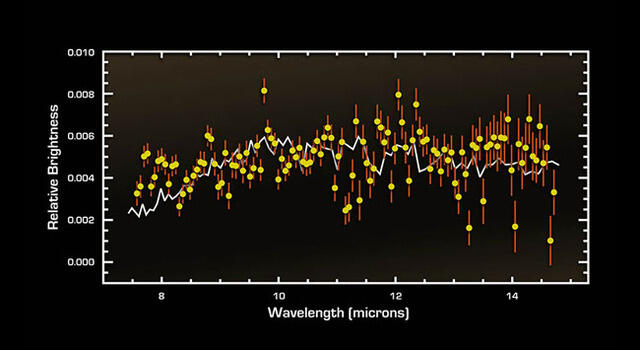
This spectrum has a double hump. One hump representing the reflected radiation and the second due to thermal emission.
The appearances of the clouds of this planet are puzzling phenomena. Although research suggests that compounds present in the planet’s atmosphere may explain the existence of colors in its atmosphere, it is impossible to achieve those colors at the low temperatures of Jupiter clouds. The most mysterious thing is that colors that should be observed at relatively warmer temperatures are observed at very low temperatures; furthermore, research has also shown that these colors of the clouds change with time thus making it difficult to understand.
Works Cited
Beisser, Kerri 2013, Spacecraft overview. New Horizons: NASA’s Pluto-Kuiper Mission. Web.
Harvey, Samantha and Autumn Burdick 2012, Missions to Jupiter: New Horizons. Solar System Exploration. Web.
Nine Planets Organization 2013, Jupiter: nine planets.Web.
Owen, Tobias Chant 2013, Early history of Jupiter: Encyclopedia Britannica. Web.
Thinkquest Education Foundation 1999, Jupiter. Beyond Our Skies: Discovering the Cosmos. Web.